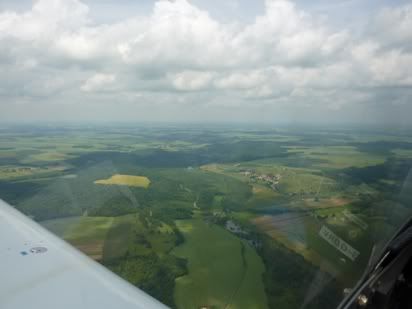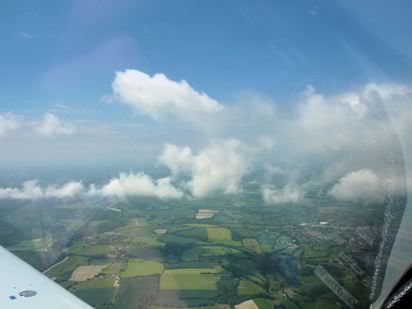LFLV DCT MOU DCT LFQB
Indeed, from the hotel window the weather looked bad. Overcast with low-ish cloud and it had obviously been raining. So I went downstairs to pick up the WiFi on my netbook and check the forecasts and TAFs etc. I have to say I was very disappointed with my Skybook subscription as it seemed to only have the TAF’s and METARs for the same overseas airfields as the UK Met Office. So I won’t renew with them, instead I’ll switch to AvBrief as I was far more impressed with the facilities that Derek was showing me on that service in Cannes. But from what I could determine, the weather was going to be fine in Dijon and Troyes and north, just dodgy here. So if I could get out and scud-run the 130 odd miles to Troyes, I should be OK.
We eat breakfast at the Ibis Hotel and got a taxi to the airport. My plane was the only one still out, the others from last night must all be in the hangars. I prepped the plane and eyed the weather. It wasn’t quite as bad as it seemed in town now I had the horizons in sight. Lateral visibility was good and I thought the low stuff was few or scattered and thinnish, so maybe I could get on top. I didn’t refuel here as I didn’t need to, but wouldn’t be able to go too much past Troyes. I started up and called the tower and was not surprised to get no response. So I gave blind calls in French as I carried out power checks at the intersection for runway 01, which is what the windsock indicated. Vichy really was a very nice airfield. Huge runway (2200m) and a huge terminal and a thriving aeroclub, but absolutely nothing happening. If you go there, get AVGAS as soon as you can if you need it and be prepared to speak and understand French. They are very relaxed and happy for you to land. It almost reminds me of those deserted airfields in the US where you self-announce.
I lined up and was away. I levelled off initially at 1500’ (bearing in mind that Vichy was already at 800’ elevation. I quickly came to the conclusion that although I ‘could’ scud run safely enough to the north (but no other direction due to ridges and hills that surround Vichy in a sort of U shape), that I could also easily get on-top, so I climbed to 3500’ where I was clear of the cloud and in sight of the ground. I contacted Clermont Information and got the usual flight information service with no one else apparently on frequency.

VMC on top near Vichy
We trundled along towards the MOU VOR and I could see some big ‘vertical development’ in cloud in the distance over where I would guess Dijon would be – glad I wasn’t near that! I turned slightly at MOU on track for Troyes. With about 40 miles still left to go, the cloud was gradually rising and getting thicker so I would either have to climb a fair bit or dip below. Well, I had to go down in 30 miles or so so I may as well do so now. Well, the visibility below wasn’t good at all and I had to get down to 1200’ before I could see sensibly – oh well! So I scud ran the last 40 miles into Troyes.
I called up Troyes with 10 miles to run and they were their usual relaxed selves and asked me to report field in sight for a downwind join for runway 17. I saw it in the soup at 4 miles and carried out the join. Came in for probably the best landing of the trip and made it for the intersection to turn off. Straight to the pumps and this time I managed to get the self service working with my credit card and filled her up for the long last leg home.
Parked up and out into reception for a drink and the final bit if flight planning. Made A trip to the on airfield Meteo service and he gave me the good news, no problems on the flight back!!

So that's what Troyes looks like in the sunshine!
This was my last leg of the trip back to Gloucester from Troyes. The route was simple enough.
LFQB DCT CTL DCT LFAT DCT ALESO DCT SFD DCT GWC DCT EGBJ
I cleared customs out at Troyes (in reality no one there and probably never is, but there is a sign and desk for where they would sit!). I had already filled up at the automated AVGAS pump (which accepts UK credit cards) for what would be about a three hour leg. There was a minimal crosswind from the left, little more than a breath or air as I called ready for departure on runway 17. He asked me to line up and declare when ready for take-off (which they seem to do in France). I did and was immediately cleared for take-off. The take off and climb out was good as I carried out a climbing turn onto track in a NNW direction to the CTL VOR.
The cloud had thinned and risen a bit since landing but UI stayed under it at 2000’ for a few miles, then realised how scattered and thin it was and climbed to FL4500’ where I sat happy as Larry until the GWC VOR. Contacted the appropriate French ‘Information’ channels on the radio and given the usual squawk and occasional traffic information. This really is a good service and very quiet compared to the frenetic London Information or Farnborough Radar. Having said that, when I transferred to Lille Information, they sounded like they were talking down a drainpipe and were quite hard to pick out. There was another UK aircraft having trouble understanding them as well, but no big deal.

Typical French countryside
CTL came up soon enough and I noticed that the airspeed was pretty much the same as the reported groundspeed on the GPS. I also noticed smoke going nearly straight up, so no wind to speak of. I committed this to memory so in case of say engine failure and a forced landing, I wouldn’t have to worry about finding a field into wind, one less thing to worry about. These are the sort of thoughts that go through your head flying single engine aircraft!
Approaching Le Touquet I tried for some higher altitude photos of the airfield just for fun as I coasted out in a straight line to the SFD VOR passing the ALESO reporting point on the way. I said goodbye to Lille (and their drainpipe) and managed to get a word in edgeways to London Information. I trundled along over the channel where the sky was clear, but there was no horizon at all, just the usual thick band of grey. I had to fly partly by instruments as the visual clues were wrong and making me turn. We called coasting in over SFD then went on listening watch to a busy Farnborough Radar as we flew along past Brighton at 4000’.
Just past GWC VOR at 4000’ we started to pick up some scattered cumulus above us. We could maintain this altitude generally apart from a few dodges around some of the lower bits. We called Farnborough Radar and got a basic service. We were warned about intensive gliding around Lasham (as usual). This is a pain as there is a narrow airspace constriction between Lasham to the east and Southampton CTR to the west. Gliders and very hard to spot and are always twisting and turning (which I suppose should make them easier to spot, but it doesn’t seem to as they are such ‘skinny’ sods!). My wife is good at spotting these and got most of them before I did.

It could only be England
Around Membury we switched to Brize Radar who didn’t seem busy and warned us about parachuting at South Cerney (as usual), so I said I would route well clear over Fairford (as usual). We were still at 4000’ as I picked up the Gloucester ATIS. Wind 210 / 06 and runway in use 27 – damn, still not using 04 / 22, I wonder why this is closed. Never mind, hardly a crosswind at all given what we have been through on this trip, but don’t under estimate it either!
We switched to the combined Gloucester frequency and were given a straight in approach to left base for 27. Back in familiar territory now. Final looked good and a nice landing for my last landing of the trip. Asked for and given a backtrack to A2. Trundled in and parked up outside the hangar and shut down – silence – wow! My wife got out and I followed as she started to unload the plane while I hit the hangar for buckets, plane shampoo and sponges. We both gave the plane a quick wash paying particular attention to the fly-splat areas and getting all of this off.
We had just finished the washing when I noticed that the plane just didn’t look right. Then it dawned that it was lower on the right than the left…….. YOU ARE KIDDING! There was a cartoon style pancake flat tyre poking out from under the starboard spat! AAARRRGH! Well, I guess if it had to happen, my home base would be the best place. Manuel did explain how to get the spats off and how to fit the jacking plate, but I didn’t have any suitable tools, so started scuttling around the airfield to find tools to help me. I managed to get all of the spat screws off except two on the underside that I couldn’t get to as they were virtually on the ground. So I had to jack the plane. Out to the car to get my own car jack and some help from Steve Noujam who was in the hangar to show me how to fit the jacking plate (I had forgotten). I jacked it and got the final few screws off (please don’t ask me how many screws hold the spat together, it was too many to count!). OK, now the spat is off, how the hell do I get it into the hangar without damaging the wheel. So I went in and asked Phil Matthews the CFI at Cotswold Aero Club if he had any bright ideas. Between him and Steve Noujam, we used a compressor to re-inflate the tyre while Phil lifted the starboard wing, hoping it would stay inflated long enough for us to wheel it back into the hangar. It did but was flat again within 5 minutes. No obvious tyre damage and now sound or feel of air escaping.
I cleaned the Perspex and tidied the plane up and packed the seat covers that needed a wash after my episode near Pisa. I tried to ring Manuel, our aircraft maintenance member, but no answer on his mobile, so when we got home, I emailed all in the group about the flat tyre and that there was now about 1.6 tacho hours until the 25 hour check was due, hardly surprising as it was a planned 20 hour or so trip anyway.
